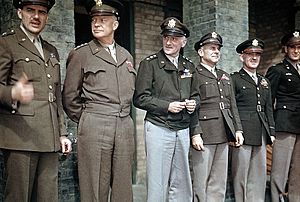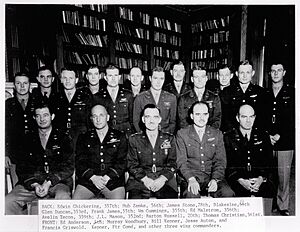Donald Blakeslee facts for kids
Quick facts for kids
Donald James Matthew Blakeslee
|
|
|---|---|
 |
|
| Born | September 11, 1917 Fairport Harbor, Ohio |
| Died | September 3, 2008 (aged 90) Miami, Florida |
| Buried | |
| Allegiance | United States Canada |
| Service/ |
United States Army Reserve (1938–40) Royal Canadian Air Force (1941–42) United States Army Air Forces (1942–47) United States Air Force (1947–65) |
| Years of service | 1938–1965 |
| Rank | Colonel |
| Unit | No. 401 Squadron RCAF |
| Commands held | 4440th Aircraft Delivery Group 27th Fighter-Escort Group 4th Fighter Group 335th Fighter Squadron No. 133 (Eagle) Squadron RAF |
| Battles/wars | World War II Korean War |
| Awards | Distinguished Service Cross (2) Silver Star (2) Legion of Merit< Distinguished Flying Cross (8) Air Medal (8) Distinguished Flying Cross (United Kingdom) |
Donald James Matthew Blakeslee (born September 11, 1917 – died September 3, 2008) was a very brave and skilled pilot. He was an officer in the United States Air Force. His amazing flying career started in World War II with the Royal Canadian Air Force. He flew fast Spitfire fighter planes.
Later, he joined the famous Royal Air Force Eagle Squadrons. These were groups of American volunteer pilots. In 1942, he moved to the United States Army Air Forces. Donald Blakeslee flew more combat missions against the German air force (the Luftwaffe) than any other American fighter pilot. By the end of the war, he was a "flying ace." This means he had shot down 15.5 enemy planes.
Contents
Early Life and Flying Dreams
Donald Blakeslee was born in Fairport Harbor, Ohio. This was on September 11, 1917. He loved flying after watching the exciting Cleveland Air Races as a boy. He saved money from his job. He and a friend bought a small plane, a Piper J-3, in the mid-1930s. They flew it from Willoughby Field in Ohio.
In 1940, his friend crashed their plane. Donald decided the best way to keep flying was to join the military. So, he joined the Royal Canadian Air Force (RCAF).
Military Career: A True Hero
World War II: Flying High
Joining the Fight: RCAF and Eagle Squadrons
After training in Canada, Donald Blakeslee arrived in England. This was on May 15, 1941. He was sent to No. 401 Squadron RCAF. This squadron was part of the Biggin Hill Wing. They flew missions over France.
Donald Blakeslee first saw combat on November 18, 1941. He damaged a German Bf 109 plane. A few days later, on November 22, 1941, he got his first confirmed "kill." He destroyed a Bf 109 over France. He also damaged another Bf 109 on the same trip.
He wasn't always the best shot. But he was very good at understanding air fighting tactics. He quickly became a natural leader, both in the sky and on the ground. By summer 1942, he was an acting flight lieutenant. He received the British Distinguished Flying Cross on August 14, 1942. This award recognized his bravery and skill.
He finished his first tour of duty. He had flown 200 hours in combat. He had also achieved three victories. Donald had tried to avoid joining the American volunteer Eagle Squadrons. But he was told he might become an instructor. To stay in combat, he finally volunteered to lead No. 133 (Eagle) Squadron RAF. During the raid on Dieppe, France, on August 18, 1942, he shot down another German Fw 190. This made him an "ace."
The Mighty 4th Fighter Group
On September 12, 1942, the Eagle Squadrons became part of the USAAF's 4th Fighter Group. They flew from a former RAF base. After flying Spitfires for a few months, the group got new planes. These were the powerful Republic P-47 Thunderbolts. On April 15, 1943, Blakeslee claimed the 4th Group's first P-47 "kill." He shot down an Fw 190.
Donald Blakeslee led the 335th Squadron of the 4th FG. He led the group into Germany for the first time on July 28. He often led the group. He developed a smart tactic. He would circle above air battles. From there, he would tell his fighters where to go.

In December 1943, Blakeslee flew the P-51 Mustang for the first time. He loved it! He worked hard to get the 4th FG new Mustangs quickly. He became the commanding officer of the 4th on January 1, 1944. The 8th Air Force Command agreed to his request. But the pilots had to be ready to fly the P-51s within 24 hours. Blakeslee agreed, telling his pilots to "learn how to fly them on the way to the target."
On March 6, 1944, Blakeslee flew the first Mustang over Berlin. He was protecting Boeing B-17 and Consolidated B-24 bombers. Under Blakeslee's command, the 4th FG became one of the best groups. They shot down many enemy planes. The 4th Fighter Group passed 500 kills by April 1944. By the end of the war, the group had destroyed 1,020 German planes.
Blakeslee also led the first "shuttle" mission to Russia. This was on June 21, 1944. He flew 1,470 miles. The mission lasted over 7 hours.

Donald Blakeslee was finally grounded in September 1944. This was after several other top American aces were lost. He had shot down 15.5 enemy planes in the air. He also destroyed 2 more on the ground. He flew over 500 combat missions. He spent 1,000 hours in combat.
A historian named Barrett Tillman said Blakeslee had more missions and hours than any other American fighter pilot in World War II. Donald Blakeslee retired from the United States Air Force in 1965. He held the rank of colonel. He was called "the most decorated second world war US Army Air Force fighter pilot." British ace Johnnie Johnson said Blakeslee was "one of the best leaders ever to fight over Germany."
After the War: Continued Service
After World War II, Blakeslee kept serving in the new U.S. Air Force. During the Korean War, he was a commander. He led the 27th Fighter-Escort Group. He flew several missions in the F-84 Thunderjet. This was from December 1950 to March 1951.
In March 1963, he became a colonel. His last job was helping the Director of Operations for the Seventeenth Air Force. He retired from the Air Force on April 30, 1965.
Awards and Honors
Donald Blakeslee received many awards for his bravery and service. Some of his most important awards include:
 United States Air Force Command pilot badge
United States Air Force Command pilot badge Royal Air Force pilot brevet
Royal Air Force pilot brevet- Distinguished Service Cross (twice)
- Silver Star (twice)
- Legion of Merit
- Distinguished Flying Cross (eight times)
- Air Medal (eight times)
- British Distinguished Flying Cross
- French Croix de Guerre with Palm
Personal Life and Legacy
After retiring, Donald Blakeslee lived in Miami, Florida. He married Leola Fryer in 1944. She passed away in 2005. They had one daughter. Donald Blakeslee died on September 3, 2008, at his home. He passed away due to heart failure.
On September 18, 2008, Colonel Don Blakeslee and his wife's ashes were buried. This was at the Arlington National Cemetery. The 4th Fighter Wing, his old group, did a special flyover during the ceremony. It was a final salute to a true hero.
See also
- List of World War II air aces


